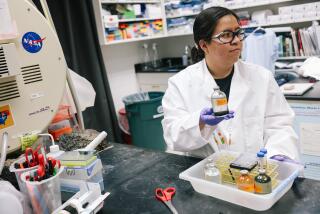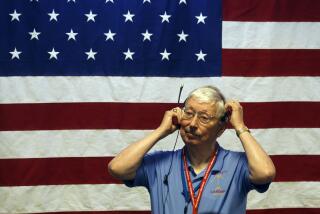30-Year Veteran of JPL Is Chosen as Its Leader
An eight-month national search for a new leader for NASA’s Jet Propulsion Laboratory has ended close to home--with the selection of 30-year JPL veteran Charles Elachi.
With years of management experience at JPL, a top-notch scientific pedigree and a detailed understanding of the technology of space instruments, Elachi was called an “obvious choice” by JPL insiders.
Still, Caltech officials said they took nothing for granted in their search, which included 74 candidates.
“We are not simply anointing a prince here,” Caltech President David Baltimore said Wednesday. “Charles simply provided insurmountable competition to any other candidate.”
It didn’t hurt, quipped Baltimore, that Elachi earned his doctorate at Caltech. “You can’t beat that,” he said.
Caltech operates the lab, which runs NASA’s unmanned planetary exploration program. The Pasadena lab has about 5,000 employees and a $1.3-billion budget.
An electrical engineer by training, the 53-year-old Elachi has participated in dozens of missions at JPL--from probing the clouds of Venus to searching for old trade routes and buried cities in the Egyptian desert.
Elachi’s interest in space started 42 years ago, when, as an 11-year-old boy in Lebanon, he heard about the launch of JPL’s Explorer 1--America’s first satellite.
He joined JPL in 1971, and calls it a place “where we have brought into reality what before were dreams.”
Elachi is stepping into a difficult position. NASA is increasing the number of missions it demands from JPL to almost 30 for the next decade while trying to hold down costs.
Such demands were responsible in large part for the loss of two Mars spacecraft in 1999.
Rather than focusing on making missions cheaper, Elachi said that during his tenure he will strive for efficiency--and realistic cost estimates. “We will tell NASA what it costs to do things,” he said.
The main goals of JPL are to establish a permanent robotic presence on Mars, plan for human exploration of Mars, probe the ice of Jupiter’s moon Europa, explore Pluto and eventually, bring samples from other planets back to Earth. “We literally will be bringing the heavens down to Earth,” he said.
Elachi, who has headed JPL’s earth and space science programs since 1994, also maintains a strong interest in exploring our own planet, its oceans, and environmental issues such as the changing climate and the ozone hole.
As for morale problems that have plagued the lab in the wake of the failures, Elachi said “things are moving on.” Many lab personnel are focusing on the April launch of a new Mars spacecraft and blueprints for two new Mars rovers.
Elachi has the support of top NASA officials. NASA chief Dan Goldin flew in from Washington to attend the “passing of the torch.”
“He is a man of incredible intellectual capacity and emotional drive,” said Goldin. “I think the future of planetary exploration is in good hands with Charles Elachi.”
He also wins high marks for technological innovation. At a young age, Elachi became an expert in the field of remote sensing. He earned a spot in the National Academy of Engineering at age 42 --and made JPL a leader in the remote sensing field. The technology has since been used to probe the surface of Venus and describe the patterns of El Nino events.
He is best known for helping to develop radar systems that can peer through the Earth’s cloud cover.
Elachi, an inveterate learner, has a number of degrees. After earning a master’s degree and doctorate in electrical engineering from Caltech in 1971, he went on to receive an MBA from USC in 1978 and, five years later, another master’s degree, this time in geology, from UCLA.
Elachi succeeds Ed Stone, a veteran planetary explorer who chose to step down this year after reaching the lab’s traditional retirement age of 65. Elachi will assume the helm on May 1, when Stone will return to his former position as professor of physics at Caltech.
More to Read
Inside the business of entertainment
The Wide Shot brings you news, analysis and insights on everything from streaming wars to production — and what it all means for the future.
You may occasionally receive promotional content from the Los Angeles Times.










